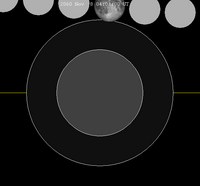November 2060 lunar eclipse
| Penumbral eclipse | |||||||||
 The Moon's hourly motion shown right to left | |||||||||
| Date | November 8, 2060 | ||||||||
|---|---|---|---|---|---|---|---|---|---|
| Gamma | 1.5332 | ||||||||
| Magnitude | −0.9356 | ||||||||
| Saros cycle | 156 (1 of 81) | ||||||||
| Penumbral | 43 minutes, 0 seconds | ||||||||
| |||||||||
A penumbral lunar eclipse will occur at the Moon’s ascending node of orbit on Monday, November 8, 2060,[1] with an umbral magnitude of −0.9356. A lunar eclipse occurs when the Moon moves into the Earth's shadow, causing the Moon to be darkened. A penumbral lunar eclipse occurs when part or all of the Moon's near side passes into the Earth's penumbra. Unlike a solar eclipse, which can only be viewed from a relatively small area of the world, a lunar eclipse may be viewed from anywhere on the night side of Earth. Occurring only about 11 hours after perigee (on November 7, 2060, at 17:15 UTC), the Moon's apparent diameter will be larger.[2]
This eclipse will be too small to be visually perceptible.
Visibility
The eclipse will be completely visible over North and South America, west Africa, Europe, and northern Russia.[3]
 
|
Eclipse details
Shown below is a table displaying details about this particular solar eclipse. It describes various parameters pertaining to this eclipse.[4]
| Parameter | Value |
|---|---|
| Penumbral Magnitude | 0.02860 |
| Umbral Magnitude | −0.93560 |
| Gamma | 1.53318 |
| Sun Right Ascension | 14h56m11.8s |
| Sun Declination | -16°46'13.7" |
| Sun Semi-Diameter | 16'08.5" |
| Sun Equatorial Horizontal Parallax | 08.9" |
| Moon Right Ascension | 02h53m43.2s |
| Moon Declination | +18°13'31.2" |
| Moon Semi-Diameter | 16'44.5" |
| Moon Equatorial Horizontal Parallax | 1°01'26.6" |
| ΔT | 92.5 s |
Eclipse season
This eclipse is part of an eclipse season, a period, roughly every six months, when eclipses occur. Only two (or occasionally three) eclipse seasons occur each year, and each season lasts about 35 days and repeats just short of six months (173 days) later; thus two full eclipse seasons always occur each year. Either two or three eclipses happen each eclipse season. In the sequence below, each eclipse is separated by a fortnight. The first and last eclipse in this sequence is separated by one synodic month.
| October 9 Ascending node (full moon) |
October 24 Descending node (new moon) |
November 8 Ascending node (full moon) |
|---|---|---|
 |

| |
| Penumbral lunar eclipse Lunar Saros 118 |
Annular solar eclipse Solar Saros 144 |
Penumbral lunar eclipse Lunar Saros 156 |
Related eclipses
Eclipses in 2060
- A penumbral lunar eclipse on April 15.
- A total solar eclipse on April 30.
- A penumbral lunar eclipse on October 9.
- An annular solar eclipse on October 24.
- A penumbral lunar eclipse on November 8.
Lunar Saros 156
- Preceded by: Lunar eclipse of October 28, 2042
- Followed by: Lunar eclipse of November 19, 2078
Triad
- Followed by: Lunar eclipse of September 9, 2147
Lunar eclipses of 2056–2060
This eclipse is a member of a semester series. An eclipse in a semester series of lunar eclipses repeats approximately every 177 days and 4 hours (a semester) at alternating nodes of the Moon's orbit.[5]
The penumbral lunar eclipses on February 1, 2056 and July 26, 2056 occur in the previous lunar year eclipse set, and the penumbral lunar eclipses on April 15, 2060 and October 9, 2060 occur in the next lunar year eclipse set.
| Lunar eclipse series sets from 2056 to 2060 | ||||||||
|---|---|---|---|---|---|---|---|---|
| Descending node | Ascending node | |||||||
| Saros | Date Viewing |
Type Chart |
Gamma | Saros | Date Viewing |
Type Chart |
Gamma | |
| 111 | 2056 Jun 27
|
Penumbral
|
1.3769 | 116 | 2056 Dec 22
|
Penumbral
|
−1.1559 | |
| 121 | 2057 Jun 17
|
Partial
|
0.6167 | 126 | 2057 Dec 11
|
Partial
|
−0.4853 | |
| 131 | 2058 Jun 06
|
Total
|
−0.1181 | 136 | 2058 Nov 30
|
Total
|
0.2208 | |
| 141 | 2059 May 27
|
Partial
|
−0.9097 | 146 | 2059 Nov 19
|
Partial
|
0.9004 | |
| 156 | 2060 Nov 08
|
Penumbral
|
1.5332 | |||||
Metonic series
This eclipse is the fifth and final of five Metonic cycle lunar eclipses on the same date, November 8–9, each separated by 19 years: The Metonic cycle repeats nearly exactly every 19 years and represents a Saros cycle plus one lunar year. Because it occurs on the same calendar date, the Earth's shadow will be in nearly the same location relative to the background stars.
|
|

|

|
References
- ^ "November 7–8, 2060 Penumbral Lunar Eclipse". timeanddate. Retrieved 13 December 2024.
- ^ "Moon Distances for London, United Kingdom, England". timeanddate. Retrieved 13 December 2024.
- ^ "Penumbral Lunar Eclipse of 2060 Nov 08" (PDF). NASA. Retrieved 13 December 2024.
- ^ "Penumbral Lunar Eclipse of 2060 Nov 08". EclipseWise.com. Retrieved 13 December 2024.
- ^ van Gent, R.H. "Solar- and Lunar-Eclipse Predictions from Antiquity to the Present". A Catalogue of Eclipse Cycles. Utrecht University. Retrieved 6 October 2018.



